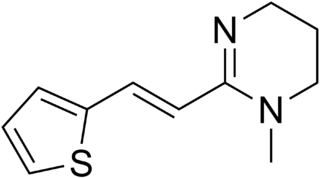Related Research Articles

Isoniazid, also known as isonicotinic acid hydrazide (INH), is an antibiotic used for the treatment of tuberculosis. For active tuberculosis it is often used together with rifampicin, pyrazinamide, and either streptomycin or ethambutol. For latent tuberculosis it is often used by itself. It may also be used for atypical types of mycobacteria, such as M. avium, M. kansasii, and M. xenopi. It is usually taken by mouth but may be used by injection into muscle.

Rifampicin, also known as rifampin, is an ansamycin antibiotic used to treat several types of bacterial infections, including tuberculosis (TB), Mycobacterium avium complex, leprosy, and Legionnaires’ disease. It is almost always used together with other antibiotics with two notable exceptions: when given as a "preferred treatment that is strongly recommended" for latent TB infection; and when used as post-exposure prophylaxis to prevent Haemophilus influenzae type b and meningococcal disease in people who have been exposed to those bacteria. Before treating a person for a long period of time, measurements of liver enzymes and blood counts are recommended. Rifampicin may be given either by mouth or intravenously.

Pyridoxine, is a form of vitamin B6 found commonly in food and used as a dietary supplement. As a supplement it is used to treat and prevent pyridoxine deficiency, sideroblastic anaemia, pyridoxine-dependent epilepsy, certain metabolic disorders, side effects or complications of isoniazid use, and certain types of mushroom poisoning. It is used by mouth or by injection.

Ethambutol is a medication primarily used to treat tuberculosis. It is usually given in combination with other tuberculosis medications, such as isoniazid, rifampicin and pyrazinamide. It may also be used to treat Mycobacterium avium complex, and Mycobacterium kansasii. It is taken by mouth.

Rifabutin (Rfb) is an antibiotic used to treat tuberculosis and prevent and treat Mycobacterium avium complex. It is typically only used in those who cannot tolerate rifampin such as people with HIV/AIDS on antiretrovirals. For active tuberculosis it is used with other antimycobacterial medications. For latent tuberculosis it may be used by itself when the exposure was with drug-resistant TB.

Rifapentine, sold under the brand name Priftin, is an antibiotic used in the treatment of tuberculosis. In active tuberculosis it is used together with other antituberculosis medications. In latent tuberculosis it is typically used with isoniazid. It is taken by mouth.

Sulfadiazine is an antibiotic. Used together with pyrimethamine, a dihydrofolate reductase inhibitor, it is the treatment of choice for toxoplasmosis, which is caused by a protozoan parasite. It is a second-line treatment for otitis media, prophylaxis of rheumatic fever, chancroid, chlamydia, and infections by Haemophilus influenzae. It is also used as adjunct therapy for chloroquine-resistant malaria and several forms of bacterial meningitis. It is taken by mouth. Sulfadiazine is available in multiple generic tablets of 500 mg. For urinary tract infections, the usual dose is 4 to 6 grams daily in 3 to 6 divided doses.
Rifampicin/isoniazid/pyrazinamide, also known as rifampin/isoniazid/pyrazinamide, and sold under the trade name Rifater, is a medication used to treat tuberculosis. It is a fixed dose combination of rifampicin, isoniazid, and pyrazinamide. It is used either by itself or along with other antituberculosis medication. It is taken by mouth.

Abacavir/lamivudine, sold under the brand name Kivexa among others, is a fixed-dose combination antiretroviral medication used to treat HIV/AIDS. It contains abacavir and lamivudine. It is generally recommended for use with other antiretrovirals. It is commonly used as part of the preferred treatment in children. It is taken by mouth as a tablet.

Pyrantel is a medication used to treat a number of parasitic worm infections. This includes ascariasis, hookworm infections, enterobiasis, trichostrongyliasis, and trichinellosis. It is taken by mouth.
Delamanid, sold under the brand name Deltyba, is a medication used to treat tuberculosis. Specifically it is used, along with other antituberculosis medications, for active multidrug-resistant tuberculosis. It is taken by mouth.

Dasabuvir, sold under the brand name Exviera, is an antiviral medication for the treatment of hepatitis C. It is often used together with the combination medication ombitasvir/paritaprevir/ritonavir specifically for hepatitis C virus (HCV) type 1. Ribavirin may also additionally be used. These combinations result in a cure in more than 90% of people. It is taken by mouth.
Ethambutol/isoniazid is a fixed-dose combination medication used to treat tuberculosis. It is a fixed dose combination of ethambutol and isoniazid. It is used along with other antituberculosis medication. It is taken by mouth.
Ethambutol/isoniazid/rifampicin, also known as ethambutol/isoniazid/rifampin, is a fixed-dose combination medication used to treat tuberculosis. It contains ethambutol, isoniazid, and rifampicin. It is used either along or with other anti-tuberculosis medication. It is taken by mouth. Side effects are those of the underlying medications. Use may not be suitable in children.
Ethambutol/isoniazid/pyrazinamide/rifampicin, also known as ethambutol/isoniazid/pyrazinamide/rifampin, is a medication used for tuberculosis. It is a fixed dose combination of ethambutol, isoniazid, pyrazinamide, and rifampicin. It is used either alone or with other antituberculosis medication. It is taken by mouth.
Lamivudine/nevirapine/zidovudine (3TC/NVP/AZT) is a fixed-dose combination antiretroviral medication used to treat HIV/AIDS. It contains lamivudine, nevirapine, and zidovudine. It is either used by itself or along with other antiretrovirals. It is a recommended treatment in those who are pregnant. It is taken by mouth twice a day.
Podophyllum resin, also known as podophyllum or podophyllin, is a resin made from the roots of the American mandrake. It is used as a medication to treat genital warts and plantar warts, including in people with HIV/AIDS. It is not recommended in HPV infections without external warts. Application by a healthcare provider to the skin is recommended.
Isoniazid/pyridoxine/sulfamethoxazole/trimethoprim (INH/B6/CTX) is a fixed-dose combination medication for the prevention of opportunistic infections in HIV/AIDS. It combines isoniazid, pyridoxine, sulfamethoxazole, and trimethoprim. Specifically it is used to prevent tuberculosis, toxoplasmosis, pneumonia, malaria, and isosporiasis. It is taken by mouth.
Dolutegravir/lamivudine/tenofovir (DTG/3TC/TDF) is a fixed-dose combination antiretroviral medication used to treat HIV/AIDS. It is a combination of dolutegravir, lamivudine, and tenofovir disoproxil. As of 2019, it is listed by the World Health Organization (WHO) as the first line treatment for adults, with tenofovir/lamivudine/efavirenz as an alternative. It is taken by mouth.
References
- 1 2 3 4 5 6 World Health Organization (2009). Stuart MC, Kouimtzi M, Hill SR (eds.). WHO Model Formulary 2008. World Health Organization. p. 142. hdl: 10665/44053 . ISBN 9789241547659.
- ↑ World Health Organization (2019). World Health Organization model list of essential medicines: 21st list 2019. Geneva: World Health Organization. hdl: 10665/325771 . WHO/MVP/EMP/IAU/2019.06. License: CC BY-NC-SA 3.0 IGO.
- 1 2 "Isoniazid/rifampin Side Effects in Detail - Drugs.com". www.drugs.com. Archived from the original on 21 December 2016. Retrieved 18 December 2016.
- ↑ "Isoniazid / rifampin Use During Pregnancy | Drugs.com". www.drugs.com. Archived from the original on 21 December 2016. Retrieved 18 December 2016.